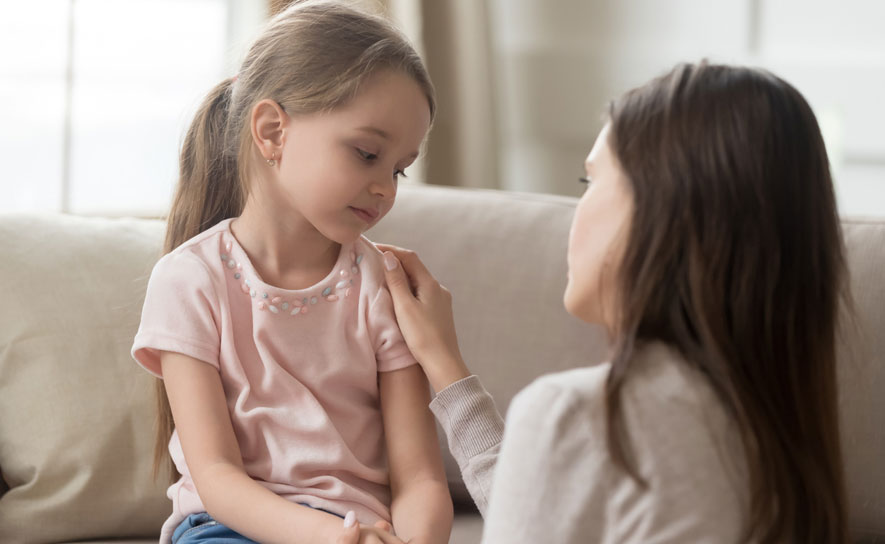USA Swimming News
COVID-19: How to Keep Kids Calm and Accountable from TrueSport

by TrueSport
As a parent during these uncertain and difficult times, the correct way to talk to your kids about COVID-19 might feel like walking a tight rope. How much should you share? How do you talk about school closures? How do you explain the importance of social distancing and CDC guidelines without terrifying them? Essentially, how do you keep kids both calm AND accountable?
There is no single script that works in these situations, but there are some general principles for communication to make sure kids feel safe and understand their part to play in the current crisis.
Use this as an opportunity
Particularly with young children, it’s tempting to hide the real reason behind canceled classes, sports, and playdates. However, board-certified family physician and TrueSport Expert Deborah Gilboa, MD, who specializes in youth development and resilience, is quick to remind parents that this grave time can also be an amazing opportunity to help our kids navigate the real world, rather than trying to protect them from reality.
“This is an opportunity to help our kids start to build the skills they will need the next time that upheaval and uncertainty comes to them,” Gilboa says. “Outside of global crisis, upheaval and uncertainty can come to kids when you need to move, or you get unexpectedly fired, or there's a divorce.”
She adds that it’s important to be developmentally appropriate: Transparency is important, but you don't have to be completely honest. Telling a 5-year-old about the current death toll or going over the epidemiology of viral replication doesn’t help, and it’s probably more appropriate to explain that there’s a virus making a lot of people sick so we have to start taking action, which may mean manageable things like staying at home and washing hands more.
Understand your role
Gilboa also explains that your job is to comfort kids and make them feel safe, which may seem difficult when anxiety threatens to overwhelm you. “You should not assume that kids are a safe place for all of your emotions,” Gilboa says. Try to find a balance where you share your emotions while being aware that your children are looking to you to be the strong one.
You don’t have to have all the answers either. Gilboa adds that it’s important to be a resource for kids but remain honest and be willing to say ‘I don’t know’ when asked a tough question. "Letting kids see when things aren't good is actually a positive,” she adds, “As long as you're still there for them."
Activity: Create Coping Mechanisms
Gilboa recommends sitting down as a family to create a list of coping mechanisms for this current crisis and for future times of upheaval. Follow the steps:
- As a family, make a giant list of every coping mechanism that you use, from binge-watching TV to going out for a run. Make the list as extensive as possible, including both healthy and unhealthy strategies.
- Next, scratch out the coping mechanisms that are damaging to yourself or to someone else. You can keep the neutral items, like binge-watching TV, since that’s unlikely to harm anyone. As a family, you might need to debate what’s acceptable to everyone and when various mechanisms can be applied. No two families’ lists will look alike!
- Copy that new list over to a clean sheet of paper: This is your list of neutral and positive coping mechanisms. (Save this list, since you can use it when a different crisis arises.)
- Lastly, for this crisis, look at the list and make a new one of all the coping mechanisms that you can use now. Things like shopping or getting dinner with a friend will get crossed off for now. Keep this final list where everyone can see it so that coping strategies are top of mind.
Add context
For most kids—even teenagers whom you assume understand the gravity of the current situation—it’s hard to see beyond their own lives. So, you may need to put things in context for them.
Gilboa explains, “Keep coming back to a value that you want to teach to your kid. If you have an inquisitive six-year-old and he asks how many people are dead, you can say, ‘A lot. And it's important for us to know what we can do to try and keep that number down as best as we can.’
“If your high-schooler asks the same question, you might say, ‘Sweetheart, as of this morning, 37,000 people have died of this virus. I understand that you want to see your friends, and that feels really compelling to you. Can you see why it doesn't feel as compelling to me?’”
Check for misinformation
“When a tough topic comes up, start by doing what every second-grade spelling teacher does: Give a pretest,” says Gilboa. “You can ask, 'What have you heard? What do you know?’”
This helps inform how much you need to tell kids and what perceptions you may need to correct based on what they’ve overheard or misunderstood.
“Kids tend to assume that they are the reason for everything: 'I didn't wash my hands so the whole world is dying,’” Gilboa said.
Use reputable sources for your own information, like the CDC or WHO, and don’t exaggerate what your child can to do to keep themselves and others safe.
Lead with empathy
You might find yourself frustrated when your child is angry or devastated about a game or party getting canceled. To you, it’s not a big deal, but remember that your child probably doesn’t understand the scope of what’s happening in the world. "Especially with young athletes, for these events that they're training for to be canceled is very disappointing,” says Nadia Kyba, MSW, TrueSport Expert and President of Now What Facilitation.
"And yes, it’s not life and death, but they're grieving something that's not going to happen for them, and they're dealing with a loss. Your role is to show empathy. When you don't legitimize people's feelings when they experience disappointment, then it just leads them to feel shame. To show empathy, try telling them about a time that something you wanted to do was canceled or you faced a similar disappointment.”
Activity: Communicate with Empathy
Struggling to communicate with empathy? Kyba has a list of steps and statements to help you support someone’s grief through empathy while also empowering them to look for their own realistic solutions to move forward.
Start with an empathy statement:
I understand how you feel.
You must feel so hopeless.
You’re in a tough spot here.
I can feel the pain you feel.
I wish you didn’t have to go through that.
No wonder you are upset.
Then a statement that aligns you with them:
I am on your side here.
Once they are ready, ask open-ended questions to help them move forward and problem solve:
Tell me more…
What next…?
What do you see as your options?
What I am hearing you say…
What am I missing?
What are you thinking…?
Don’t overshare stressful details
If you’re a family who regularly talks about finances, then you can talk to your kids about the impact COVID-19 is having on the household, says Kyba. But if sharing that information isn’t the norm, tread carefully with those topics, since kids will soak up your feelings and anxieties.
In general, “It is good to share enough emotion that kids feel a connection and understand you’re going through the same things as them, but not so much truth that it's terrifying for them," explain Kyba.
Activity: F.I.G.H.T. COVID-19
TrueSport Expert Kevin Chapman, a licensed clinical psychologist and founder of the Kentucky Center for Anxiety and Related Disorders, recommends teaching your child to F.I.G.H.T. COVID-19. Here’s how:
F: Focus on what you can control right now. "It's really important to recognize that there's a lot of uncertainty, and it's normal to be anxious right now,” Chapman says. "But what can I do? What can I control? I can control my behavior. I can follow health guidelines, but I can also still connect with friends online and so focus on what I can do.”
I: Identify negative thoughts. “Negative thoughts are normal, but if I'm thinking only negative thoughts about what's happening, that's what feeds the anxiety and makes the uncertainty even more uncomfortable,” he explains. "So, I need to identify those thoughts that I'm having that perpetuate these emotional cycles.”
G: Generate alternative thoughts. "These thoughts don't necessarily need to be positive, it's just about being flexible,” Chapman explains. "Can I entertain different possibilities? Can I say, ‘Yes, it could last longer than I'd like and that kind of stinks. Yes. But it could be that I'm going to make even more memories when things move on. It could be that I can still have fun with my friends.’"
H: Highly adaptive behaviors. “What are the things I can do to not only help other people, but to also stimulate my endorphins?” Chapman asks. "Can I exercise with fitness apps with my friends? Can I have a movie night over FaceTime with friends?”
T: Teach someone else to do the same thing. "We're all in this together. And I think that it's essential to teach other people to use these same coping strategies,” he concludes.
Takeaway
Communicating with kids about COVID-19 and other stressful situations is not an easy task, but with empathy, honesty, and careful information sharing, you can help your young athlete or student feel safe and act responsibly. With the communication and coping exercises, you can also help your family deal with crisis together.

About TrueSport
TrueSport®, a movement powered by the experience and values of the U.S. Anti-Doping Agency, champions the positive values and life lessons learned through youth sport.
TrueSport® inspires athletes, coaches, parents, and administrators to change the culture of youth sport through active engagement and thoughtful curriculum based on cornerstone lessons of sportsmanship, character-building, and clean and healthy performance, by creating leaders across communities through sport.
